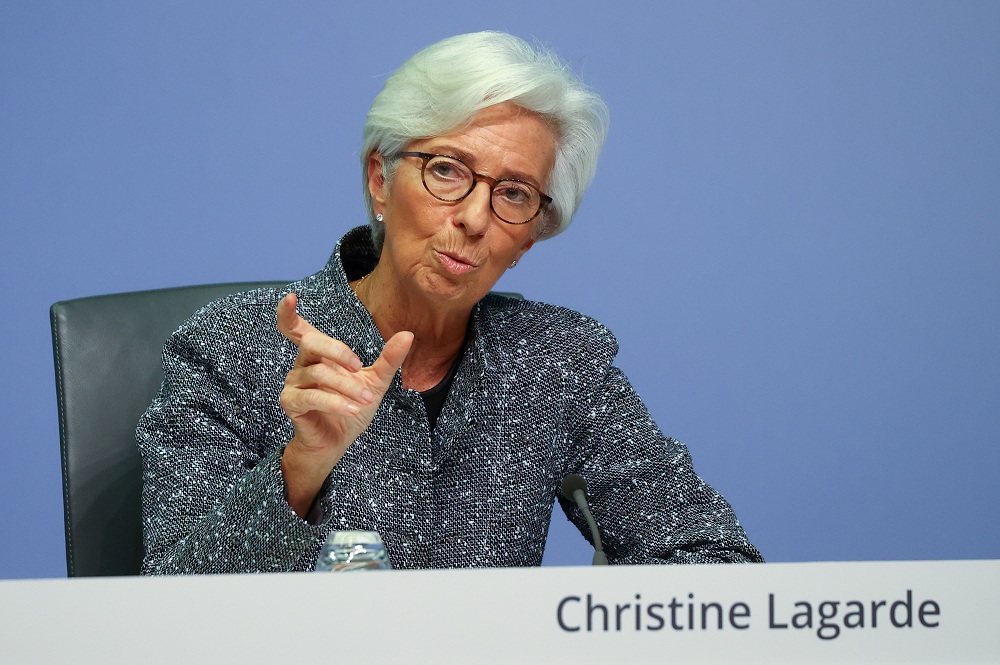Will ECB be at greater risk of falling behind the curve than the Fed?
A big issue for bond and currency markets is the extent to which central banks fall behind the curve as they look to respond to rising inflation.

ECB won’t be quick to tighen monetary policy, as reflected in the relative stability in front-end euro zone yields. Photo: ECB President Christine Lagarde
Those that fall behind might expect to see their currencies suffer as real rates decline while, in the bond market, yield curves may steepen if short rates are held steady while rising inflation expectations lift longerdated yields. But working out just where major central banks lie on the inflation curve may be harder than it sounds.
To see this, consider what’s happening in the US and the euro zone. In Mr. Steve Barrow, Head of Standard Bank G10 Strategy’s view, there are two things to note about how markets have moved in the last two months. On rates, he has seen a dramatic rise in short-term yields in the US. Two-year note yields have doubled since the start of September; rising from 0.2% to over 0.5%. Over the same period, front end yields in Germany, for instance, have hardly budged; rising only around 7 bps to -0.63% from -0.7% at the start of September. This may suggest that the market thinks the US has a bigger inflation issue and that the Fed will need to get on with tightening policy, while the ECB can afford to hang tight.
However, if we look at market pricing of forward-starting inflation swaps, we see that there’s been a bigger rise in euro zone inflation expectations than in the US. The 5yr forward starting 5yr inflation swap in the euro zone has risen by around 40-bps since the start of September, while the US version is up a much smaller 25- bps. In other words, this seems to be suggesting that the market might be getting more concerned about inflation in the euro zone than the US and perhaps this concern is fuelled by the expectation that the ECB won’t be quick to act, as reflected in the relative stability in front-end euro zone yields.
The fact that the US yield curve has flattened significantly over the same period would also seem to suggest that the market believes that the Fed has inflation risks under some degree of control. For instance, the 2s-10s curve in the US has flattened by around 25-bps in recent weeks while the German curve has only managed around 7-bps of flattening. Of course, we do have to take into account that euro zone yields are much lower than the US across the curve and hence the relative discrepancy is not as large as implied by the size of the basis point moves, but this still takes little away from the fact that the last few weeks seem to have suggested that the market might see the ECB at greater risk of falling behind the curve than the Fed.
But one problem with this interpretation is that it is not being played out in the FX market where euro/dollar has been very stable indeed despite all this frenetic activity, particularly the sharp rise in front-end US yields. If the market really fears that the ECB risks falling behind the inflation curve, we might anticipate some weakness in the euro, but that’s not happened. We have to say that we are not too surprised by this.
“For our sense is that if one of these two banks’ risks falling behind the curve it is the Fed, not the ECB. There are a number of reasons for this. One is that that the Fed has an employment objective as well, whereas the ECB is driven only by inflation. What’s more, the Fed’s employment objective has been pushed in a direction that actively encourages playing a bit harder and faster with inflation risks. Last year’s monetary policy strategy change from the Fed saw the bank push for ‘inclusivity’ in its maximum employment objective. Another issue is that the Fed is no longer forecast based but, instead, is pledged to wait to see the whites of inflation’s eyes before hiking. A third factor is that the Fed is more attuned to not just the domestic risks of tightening too quickly; it is also very aware of the international connotations given the dollar’s dominant global role. In sum, while we believe that the Fed will lift rates before the ECB, we’d still lean towards the latter as the more likely to keep inflation in check and, as long as that’s the case it leaves us more favourable to the euro than the dollar”, Mr. Steve Barrow said.








